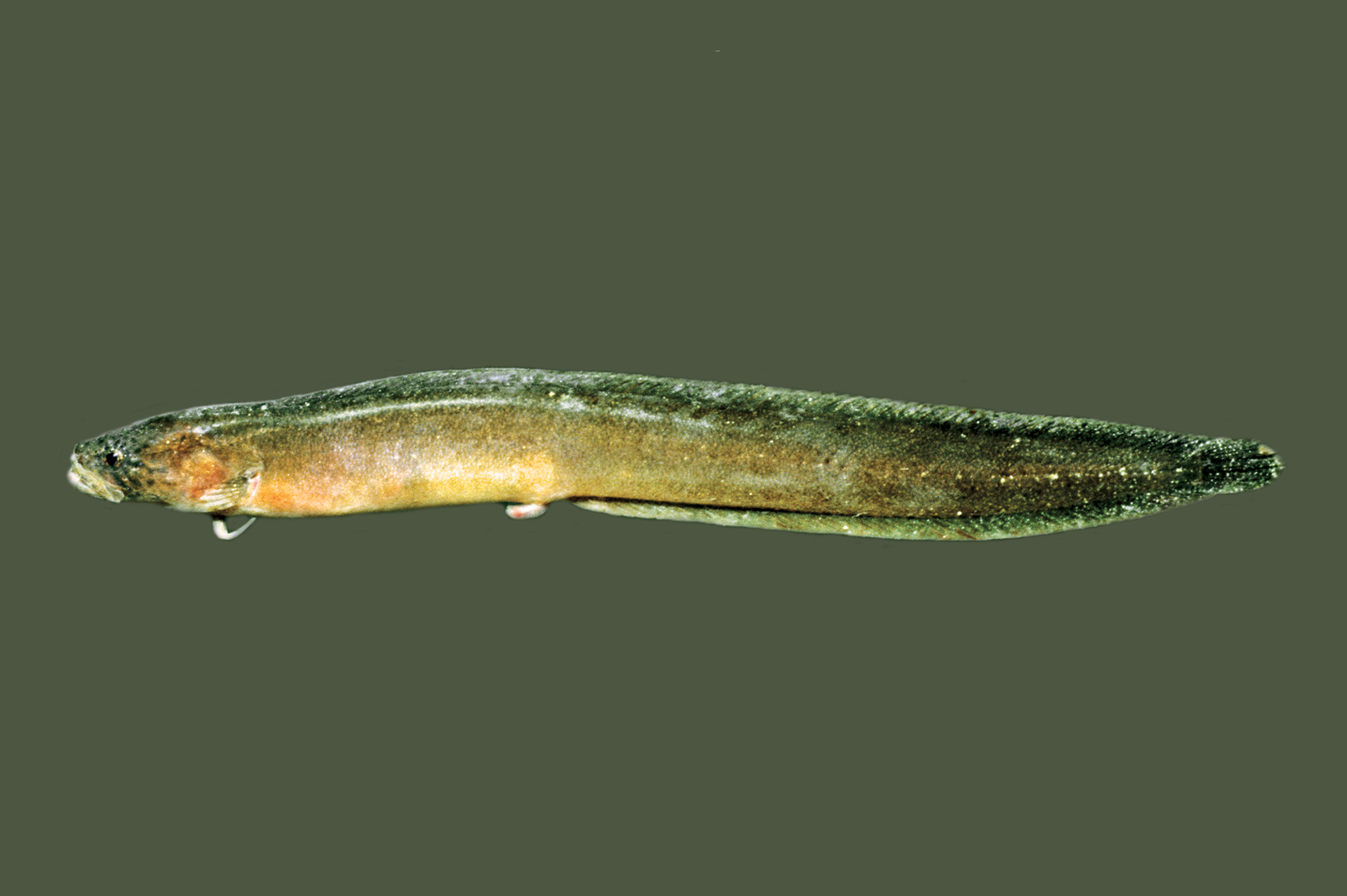- Classification
- ACTINOPTERYGII
- PERCIFORMES
- CLINIDAE
- Ophiclinus
- brevipinnis
Shortfin Snake Blenny, Ophiclinus brevipinnis George & Springer 1980
Other Names: Shortfin Snakeblenny

A Shortfin Snake Blenny, Ophiclinus brevipinnis. Source: Rudie Kuiter / Aquatic Photographics. License: All rights reserved
Summary:
A brownish snake blenny with a yellowish to orange abdomen, fine white speckles posteriorly on the sides and fins, radiating dark wavy lines around the eyes, and brown pectoral fins with a transparent outer half. This species can be recognised by its rather uniform colour pattern and very short pectoral fins.
Cite this page as:
Bray, D.J. 2022, Ophiclinus brevipinnis in Fishes of Australia, accessed 02 Jul 2025, https://fishesofaustralia.net.au/home/species/1104
Shortfin Snake Blenny, Ophiclinus brevipinnis George & Springer 1980
More Info
|
Distribution |
Endemic to southern Australia, from Kangaroo Island and the SA Gulfs, South Australia, to the Recherche Archipelago, Western Australia. Inhabits shallow reefs, usually under rocky ledges and around weed at depths to 15 m. |
|
Features |
Dorsal fin LXIII-LXVII, 1; Anal fin II, 42-46; Caudal fin 13; Pectoral fin 8; Pelvic fin I, 2; Vertebrae 25-27 + 45-49 = 72-74. Body shallow (14-15% SL), very elongate, compressed, gradually tapering to shallow caudal peduncle. Head small (18-19% SL); eyes small (18-19% HL); tube of anterior nostrils without fleshy flap at tip,positioned near upper lip; mouth small (upper jaw length 36-37% HL), nearly horizontal, maxillae just reaching beyond hind edge of eyes; teeth conical, moderately large, band at front of each jaw, single row laterally; roof of mouth with curved row of teeth. Scales tiny, cycloid, not overlapping; lateral line not associated with scales, consisting of 10-19 pores originating above each opercle, followed by series of pit like depressions; front pore in series of pores running down and forward on each cheek unpaired. Singular dorsal and anal fins with very elongate bases and fairly uniform heights, both broadly joined by membranes to caudal fin, dorsal arising above opercular edges, membranes between anal fin rays not distinctly notched at edge; caudal fin pointed. Pectoral fins moderately small, length about twice eye diameter. Pelvic fins much longer than eye diameter, arising slightly in front of and below pectoral fin bases. |
|
Colour |
Head and body variably or uniformly mottled with brown; dorsal, anal, and caudal fins brown mottled, often with fine white speckles posteriorly on sides and fins; eyes encircled by short radiating dark brown bands or wavy lines, which may be restricted to the posterior part of the orbital rim; pectoral fins mottled brown basally, outer half pale to clear; pelvic fins pale or with faint brown bands. |
|
Similar Species |
Ophiclinus brevipinnis differs from the other Ophiclinus species in having a much shorter pectoral fin, fewer pectoral-fin rays, and more dorsal-fin spines, segmented anal-fin rays, and vertebrae. |
|
Etymology |
This specific name brevipinnis is from the Latin brevis (= short) and pinnis (= fin, wing), in reference to the short length of the pectoral fin (the shortest pectoral fin among species of the genus Ophiclinus). |
|
Species Citation |
Ophiclinus brevipinnis George & Springer 1980, Smithsonian Contributions to Zoology 307: 17, fig. 6. Type locality: Knob Point, Kangaroo Island, South Australia, 35°37'S, 137°15'E, depth 15 m. |
|
Author |
Bray, D.J. 2022 |
|
Resources |
Shortfin Snake Blenny, Ophiclinus brevipinnis George & Springer 1980
References
George, A. & Springer, V.G. 1980. Revision of the clinid fish tribe Ophiclinini, including five new species, and definition of the family Clinidae. Smithsonian Contributions to Zoology 307: 1-31 figs 1-14 https://doi.org/10.5479/si.00810282.307
Hoese, D.F., Gomon, M.F. & Rennis, D.S. 2008. Family Clinidae. pp. 696-722 in Gomon, M.F., Bray, D.J. & Kuiter, R.H. (eds). Fishes of Australia's Southern Coast. Sydney : Reed New Holland 928 pp.
Holleman, W., Clements, K.D., Williams, J.T. 2014. Ophiclinus brevipinnis. The IUCN Red List of Threatened Species 2014: e.T179092A1568746. http://dx.doi.org/10.2305/IUCN.UK.2014-3.RLTS.T179092A1568746.en. Downloaded on 25 October 2018.
Hutchins, J.B. 1994. A survey of the nearshore reef fish fauna of Western Australia's west and south coasts — The Leeuwin Province. Records of the Western Australian Museum, Supplement 46: 1-66 figs 1-6
Hutchins, J.B. 2005. Checklist of marine fishes of Recherche Archipelago and adjacent mainland waters. pp. 425-449 in Wells, F.E., Walker, D.I. & Kendrick, G.A. (eds). Proceedings of the Twelfth International Marine Biological Workshop: The Marine Flora and Fauna of Esperance, Western Australia. Perth : Western Australian Museum.
Rennis, D., Hoese, D.F. & Gomon, M.F. 1994. Family Clinidae. pp. 741-775, figs 650-684B in Gomon, M.F., Glover, C.J.M. & Kuiter, R.H. (eds). The Fishes of Australia's South Coast. Adelaide : State Printer 992 pp. 810 figs.



